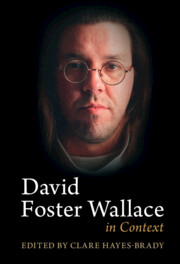Book contents
- David Foster Wallace in Context
- David Foster Wallace in Context
- Copyright page
- Contents
- Figures
- Contributors
- Acknowledgments
- Abbreviations
- Introduction
- Part I Contexts
- Chapter 1 David Foster Wallace and Narratology
- Chapter 2 A Meeting of Minds
- Chapter 3 Writing in a Material World
- Chapter 4 Confidence Man
- Chapter 5 David Foster Wallace and European Literature
- Chapter 6 David Foster Wallace and Poetry
- Chapter 7 David Foster Wallace’s “Non”-Fiction
- Chapter 8 “Thanks Everybody and I Hope You Like It”
- Chapter 9 David Foster Wallace and Visual Culture
- Part II Ideas
- Part III Bodies
- Part IV Systems
- Works by David Foster Wallace
- Bibliography of Secondary Sources
- Index
Chapter 6 - David Foster Wallace and Poetry
from Part I - Contexts
Published online by Cambridge University Press: 18 November 2022
- David Foster Wallace in Context
- David Foster Wallace in Context
- Copyright page
- Contents
- Figures
- Contributors
- Acknowledgments
- Abbreviations
- Introduction
- Part I Contexts
- Chapter 1 David Foster Wallace and Narratology
- Chapter 2 A Meeting of Minds
- Chapter 3 Writing in a Material World
- Chapter 4 Confidence Man
- Chapter 5 David Foster Wallace and European Literature
- Chapter 6 David Foster Wallace and Poetry
- Chapter 7 David Foster Wallace’s “Non”-Fiction
- Chapter 8 “Thanks Everybody and I Hope You Like It”
- Chapter 9 David Foster Wallace and Visual Culture
- Part II Ideas
- Part III Bodies
- Part IV Systems
- Works by David Foster Wallace
- Bibliography of Secondary Sources
- Index
Summary
This chapter examines a lesser-studied element of Wallace’s intertextual engagement: his engagements with poets, poetry and poetics. Although he once claimed that he was “not talented enough” to be a poet, Wallace’s writing was deeply immersed in and often concerned with questions to do with the nature of poetry and the figure of the poet. Some of his titles refer or allude to specific poems – from “Westward the Course of Empire Takes its Way” (George Berkeley) to The Pale King (John Keats) – while other texts, such as the short story “Here and There,” use the idea of poetry to explore the relationship between language and experience, expression and form. In his longer works, too, Wallace uses particular poets in interesting (often entertaining) ways – W. H. Auden in The Broom of the System, for example, and Emily Dickinson in Infinite Jest. In interviews and essays, Wallace declared an interest in a wide range of poets, from W. B. Yeats, Marianne Moore and Philip Larkin to Bill Knott and Stephen Dobyn. Taken together, these and further examples suggest that a more detailed account of Wallace’s writing on and about poetry will fill a particular gap in the understandings of his work.
- Type
- Chapter
- Information
- David Foster Wallace in Context , pp. 67 - 75Publisher: Cambridge University PressPrint publication year: 2022

